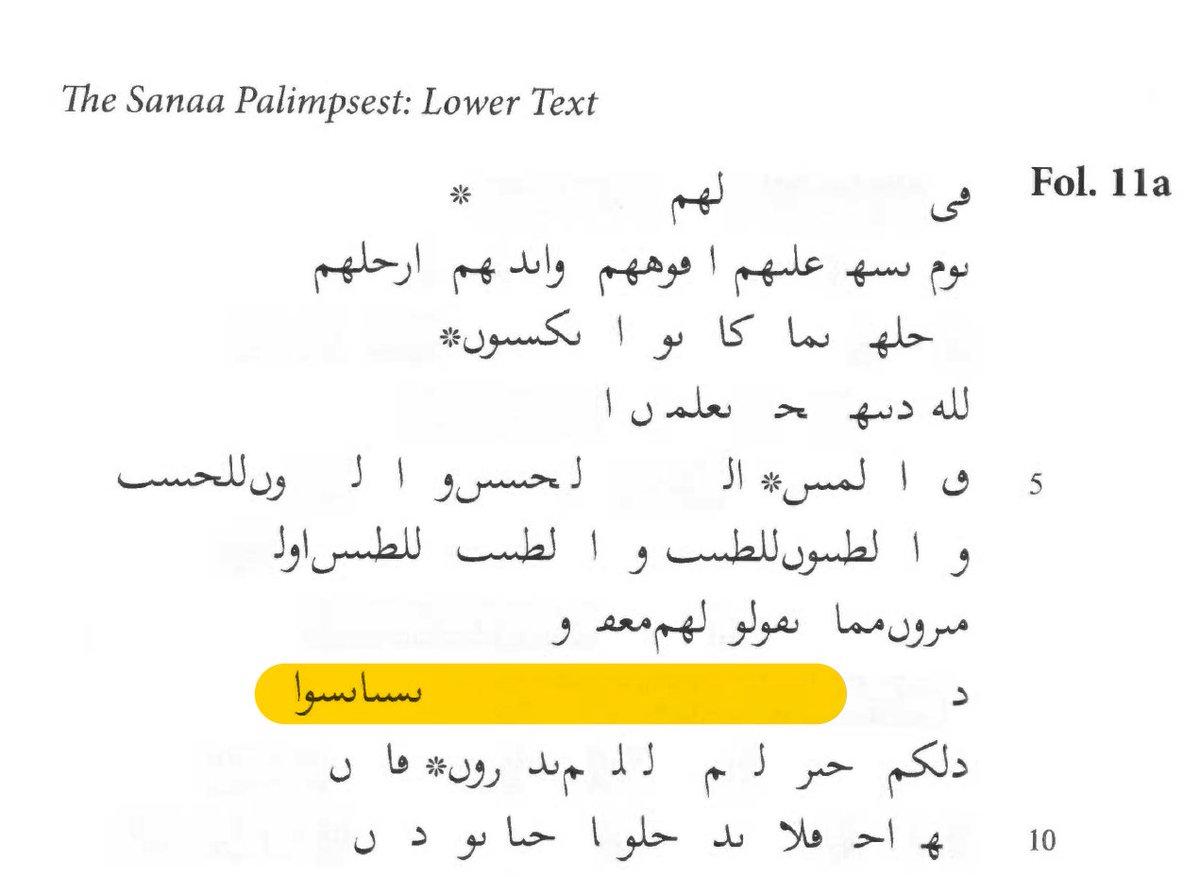Islamic literature on the Qur’an reports many textual variants that do not conform to the ‘Uthmanic skeletal text (rasm), often attributing such variants to Companions of the Prophet who allegedly had independent codices of their own. But did such variants really exist?
Some academics viewed these variants not as authentic vestiges of a pre-standardization milieu but as the fabrication of later authorities who wanted to advance certain exegetical positions through these variants. (The image is from Wansbrough's Quranic Studies [p. 203].)
But the lower text of Sana'a 1 (aka the Sana'a palimpsest) provides clear evidence that such variation existed early on. In fact, some of the non-standard variants of this manuscript are identical with or similar to those reported in the rasm and qira'at literatures!
Our 2012 edition ( https://doi.org/10.1515/islam-2011-0025) notes this fact and provides a table listing such cases of overlap.
However, in her recent work on the Sana'a palimpsest, Asma Hilali questions our findings and claims that there is no such overlap.
So let us look at some examples.
However, in her recent work on the Sana'a palimpsest, Asma Hilali questions our findings and claims that there is no such overlap.
So let us look at some examples.
Example1 (Q 33:51): the ʿUthmanic text has ātaytahunna, but the lower text has ūtīna, which is reported for Ibn Masʿūd.
To discern the lower text, go back & forth repeatedly between the normal & UV images.
3rd image is from our table, 4th image is Hilali's reading.
To discern the lower text, go back & forth repeatedly between the normal & UV images.
3rd image is from our table, 4th image is Hilali's reading.
Example 2 (Q 19:19): the ʿUthmanic text has li-ahaba, but the lower text seems to have li-nahaba (reported for Abū ʿAmr) or perhaps li-yahaba (attributed to other readers and Companions)
Example 3 (Q 8:2): the ʿUthmanic text has wajilat, but the lower text most likely has fariqat (reported for Ibn Masʿūd).
Example 4 (Q 24:27): the ʿUthmanic text has ḥattā tastaʾnisū wa-tusallimū ʿalā ahlihā, but the lower text seems to have ḥattā tusallimū ʿalā ahlihī wa-tasta’dhinū (similar to a number of reported variants).
(Note the singular pronoun after ahl, which matches baytan in the LT).
(Note the singular pronoun after ahl, which matches baytan in the LT).
Example 5 (Q 37:56): the ʿUthmanic text has la-turdīn, but the lower text seems to have la-tughwīn (reported for Ibn Masʿūd).
Example 6 (Q 2:217): the ʿUthmanic text has qitālin fīhi, but the lower text seems to have wa-ʿan qitālin fīhi (reported for a number of authorities).
Sadly there is no ultraviolet image for this folio.
Sadly there is no ultraviolet image for this folio.
Example 7 (Q 2:98): This verse refers to the angel Michael, represented as (مـٮکٮل) in the ʿUthmanic rasm and rendered in different ways (Mīkāl, Mīkāʾīl, Mīkāʾal, etc.). But the lower text seems to have (مکٮل), which matches the reading Mikayl (attributed to Ibn Muḥayṣin).
This latter (and for now last) example is in fact read correctly by Hilali, but she still rejects our suggested comparison with Ibn Muḥayṣin's reading.
@PhDniX criticizes this position in his important paper ( https://doi.org/10.1017/S0041977X19000338)
END.
@PhDniX criticizes this position in his important paper ( https://doi.org/10.1017/S0041977X19000338)
END.

 Read on Twitter
Read on Twitter![Some academics viewed these variants not as authentic vestiges of a pre-standardization milieu but as the fabrication of later authorities who wanted to advance certain exegetical positions through these variants. (The image is from Wansbrough's Quranic Studies [p. 203].) Some academics viewed these variants not as authentic vestiges of a pre-standardization milieu but as the fabrication of later authorities who wanted to advance certain exegetical positions through these variants. (The image is from Wansbrough's Quranic Studies [p. 203].)](https://pbs.twimg.com/media/Eav4Ic4XQAQgSD6.png)






























